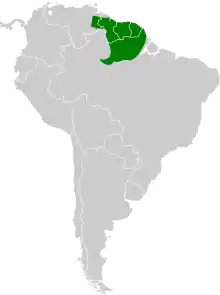Guianan warbling antbird
The Guianan warbling antbird (Hypocnemis cantator) is an insectivorous bird in the antbird family, Thamnophilidae. It is found at lower levels in humid forest in the Guianas, far eastern Venezuela (with Guyana), and north-eastern Brazil (north of the Amazon River and east of the lower Negro River and the Branco River).
| Guianan warbling antbird | |
|---|---|
.jpg.webp) | |
| Scientific classification | |
| Domain: | Eukaryota |
| Kingdom: | Animalia |
| Phylum: | Chordata |
| Clade: | Dinosauria |
| Class: | Aves |
| Order: | Passeriformes |
| Family: | Thamnophilidae |
| Genus: | Hypocnemis |
| Species: | H. cantator |
| Binomial name | |
| Hypocnemis cantator (Boddaert, 1783) | |
 | |
| Synonyms | |
|
Hypocnemis cantator cantator | |
Taxonomy
The French polymath Georges-Louis Leclerc, Comte de Buffon described the Guianan warbling antbird in his Histoire Naturelle des Oiseaux in 1779.[2] The bird was also illustrated in a hand-coloured plate engraved by François-Nicolas Martinet in the Planches Enluminées D'Histoire Naturelle which was produced under the supervision of Edme-Louis Daubenton to accompany Buffon's text.[3] Buffon did not include a scientific name with his description but in 1783 the Dutch naturalist Pieter Boddaert coined the binomial name Formicarius cantatar in his catalogue of the Planches Enluminées.[4] The specific name is from the Latin cantator "a singer".[5] The present genus Hypocnemis was introduced by the German ornithologist Jean Cabanis in 1847.[6]
The Imeri, Peruvian, yellow-breasted, Rondonia and Spix's warbling antbird were all formerly treated as subspecies of the Guianan warbling antbird. A study published in 2007 found that there were significant vocal differences as well a small plumage differences between the taxa and they are now all treated as separate species.[7][8] As presently defined, the Guianan warbling antbird is monotypic, although the subspecies notaea sometimes has been recognized.[9]
Its conservation status has been assessed as near threatened.[1]
References
- BirdLife International (2019). "Hypocnemis cantator". IUCN Red List of Threatened Species. International Union for Conservation of Nature. doi:10.2305/IUCN.UK.2019-3.RLTS.T22720560A154348671.en. Retrieved 10 December 2019.
- Buffon, Georges-Louis Leclerc de (1779). "Le Carrillonneur". Histoire Naturelle des Oiseaux (in French). Vol. 8. Paris: De L'Imprimerie Royale. pp. 246–247.
- Buffon, Georges-Louis Leclerc de; Martinet, François-Nicolas; Daubenton, Edme-Louis; Daubenton, Louis-Jean-Marie (1765–1783). "Le Carrillonneur de Cayenne". Planches Enluminées D'Histoire Naturelle. Vol. 7. Paris: De L'Imprimerie Royale. Plate 700 fig. 2.
- Boddaert, Pieter (1783). Table des Planches Enluminéez d'Histoire Naturelle, de M. d'Aubenton. Avec les denominations de M.M. de Buffon, Brisson, Edwards, Linnaeus et Latham, precédé d'une Notice des Principaux Ouvrages Zoologiques enluminées. Utrecht: Boddaert. p. 44, Plate 700 fig. 2.
- Jobling, James A. (2010). The Helm Dictionary of Scientific Bird Names. London: Christopher Helm. p. 89. ISBN 978-1-4081-2501-4.
- Cabanis, Jean (1847). "Ornithologische notizen". Archiv für Naturgeschichte (in German). 13: 186-256 [212].
- Isler, M.L.; Isler, P.R.; Whitney, B.M. (2007). "Species limits in antbirds (Thamnophilidae): the Warbling Antbird (Hypocnemis cantator) complex". Auk. 124 (1): 11–28. doi:10.1642/0004-8038(2007)124[11:SLIATT]2.0.CO;2.
- Lebbin, Daniel (August 2007). "Proposal (299): Split Hypocnemis cantator by elevating H. flavescens, peruviana, subflava, ochrogyna and striata to species rank". South American Classification Committee of the American Ornithological Society. Retrieved 20 February 2018.
- Gill, Frank; Donsker, David, eds. (2018). "Antbirds". World Bird List Version 8.1. International Ornithologists' Union. Retrieved 4 February 2018.
Further reading
- Zimmer & Isler. 2003. Hypocnemis cantator (Warbling Antbird). Pp. 645 in del Hoyo, Elliott, & Christie. 2003. Handbook of the Birds of the World. Vol. 8. Broadbills to Tapaculos. Lynx Edicions. Barcelona.
- Cadena, C.D.; Londoño, G.A.; Parra, J.L. (2000). "Nesting records of five antbird species from the Colombian Amazon". Wilson Bulletin. 112 (3): 313–317. doi:10.1676/0043-5643(2000)112[0313:NROFAS]2.0.CO;2.
External links
![]() Data related to Hypocnemis cantator at Wikispecies
Data related to Hypocnemis cantator at Wikispecies
